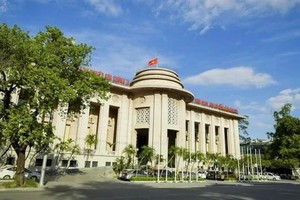Several commercial banks have lowered their deposit and lending interest rates in dong since October 15 as their commitment to the Vietnam Banking Association (VNBA).

Banks have cut their deposit interest rates by 0.2 percent points to 11 percent per annum.
Asia Commercial Bank was the first bank to apply the new interest rate on October 15.
Vietcombank and DaiA Bank got in line on October 16, followed by BIDV, Eximbank, DongA Bank, and MB Bank.
However, some banks have still maintained their promotion programs by offering money, interest rates and gifts. Therefore, their real interest rates remain unchanged at 11.2 percent per annum.
Vietnambank began lowering the lending interest rate to 11.5 percent on October 16.
Housing Bank of Mekong Delta has reduced its lending interest rates for many enterprises, with the interest rate for agricultural enterprises cut from 14.5 percent to 12-12.5 percent per year, the rate for property and food enterprises slashed from 16 to 13-14 percent and 12.5 to 11.5 percent per annum respectively.
On July 5, the Vietnamese monetary market received the event that commercial banks simultaneously cut deposit and lending interest rates in dong.
Through the consensus amongst the members of VNBA, the deposit interest rate of 11.5 percent was reduced to 11.2 percent per year. Lending rate also gradually decreased to about 12.5 percent - 15 percent per year, depending on the prioritized and preferential borrower groups.
Since then, the schedule to continue to cut down interest rates according to the government's directive (down to 10 percent per year for deposits and down to 12 percent per year for lending) had yet to be done.
It was said that higher interest rates were one of the greatest difficulties for enterprises in 2010.
In 2009, many enterprises were in favor of low interest rates, supported by the government’s stimulus policy.
In 2010, interest rates increased sharply, plus the exchange rate increased along with material prices pushed up, which boosted production costs, while the expansion of business and markets was hard due to the impacts of the financial crisis.
Therefore, the loan interest rate was too high compared to the endurance of enterprises.
On September 27, the State Bank of Vietnam officially issued Circular 19, amending and supplementing a number of important points in Circular 13 to facilitate credit institutions to boost credit growth and mobilize capital.
Therefore, the roadmap to lower interest rates was expected to be carried out by banks from October 15.
At a meeting in late September with VNBA, many commercial banks agreed to cut interest rates.
However, banks have worried that the deposit interest rate cut will not enable them to absorb excess capital if depositors expect high returns. Therefore, capital might be directed away from banks and towards higher-yield investments.
A deputy director of a Ho Chi Minh City-based bank, who wished to remain unnamed, said "We must comply with the agreement. However, banks may become involved in a promotional war to attract depositors if new interest rates do not meet customers' expectations."
VNBA general secretary Duong Thu Huong said that further interest rate cuts would be executed with prudence with respect for market behavior and depositors' expectations as inflationary pressures continued to grow during the final months of the year.
















)







